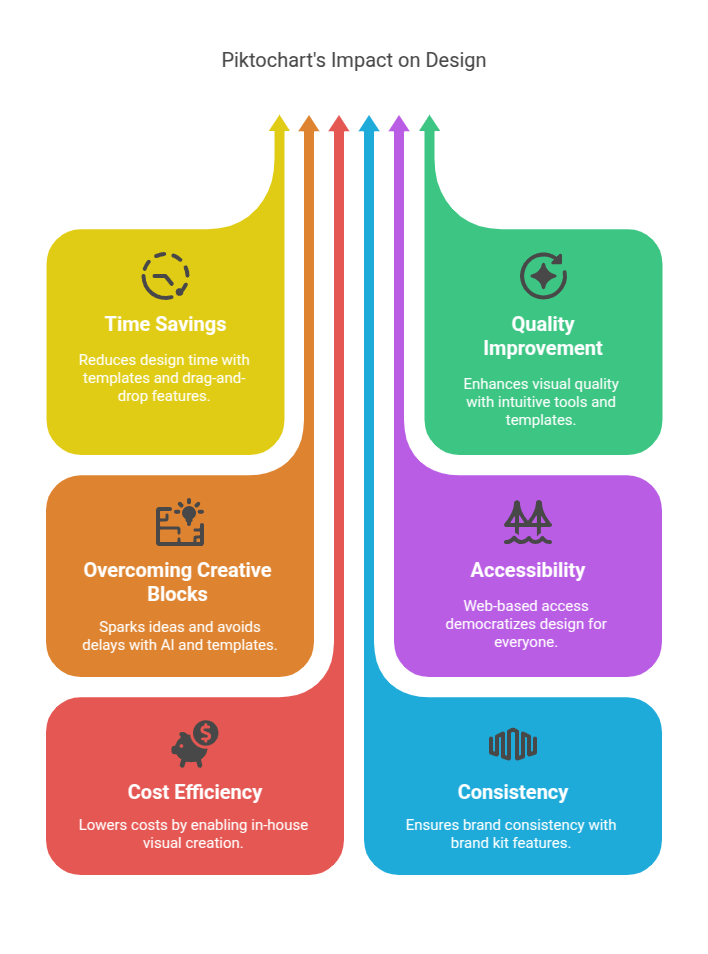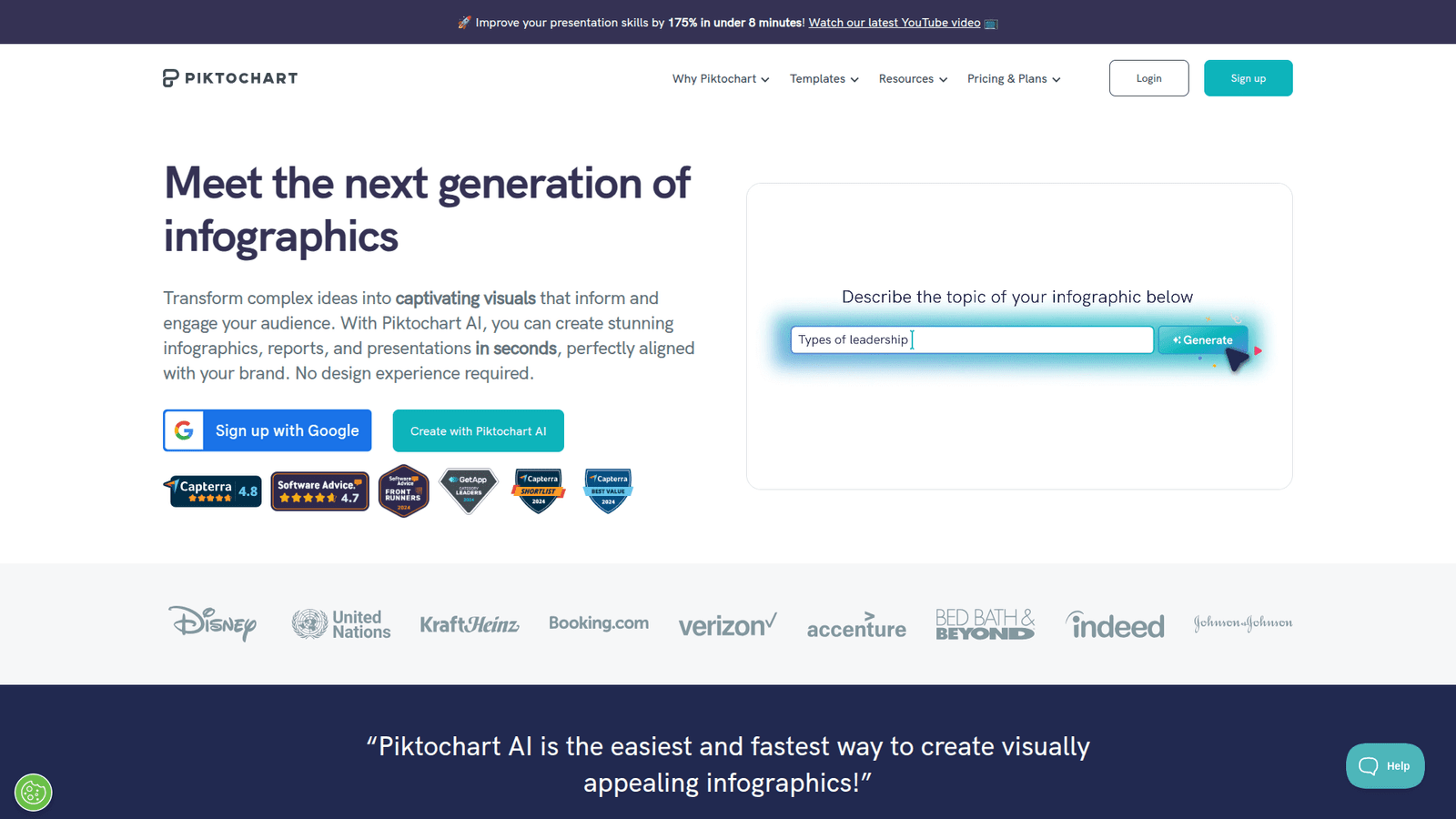Piktochart makes Banners Posters Infographics simple. Use AI for stunning visuals, faster. Get pro design results without the struggle. Try it free!
Say Goodbye to Manual Banners Posters Infographics – Hello Piktochart
Let’s be real.
Creating stunning visuals takes time.
Especially for Banners Posters Infographics.
You know the drill.
Hours spent wrestling with design software.
Trying to make data look good.
Or crafting that perfect banner that actually grabs attention.
It’s a grind.
And if you’re in Visual and Graphic Design, time is money.
Or worse, it’s missed deadlines.
Burnout.
But things are changing.
AI is showing up in design.
Making things faster.
Easier.
More effective.
One tool is making waves.
Piktochart.
It promises to simplify visual creation.
Specifically for those critical Banners Posters Infographics you need to crush your goals.
Does it deliver?
Let’s find out.
Table of Contents
- What is Piktochart?
- Key Features of Piktochart for Banners Posters Infographics
- Benefits of Using Piktochart for Visual and Graphic Design
- Pricing & Plans
- Hands-On Experience / Use Cases
- Who Should Use Piktochart?
- How to Make Money Using Piktochart
- Limitations and Considerations
- Final Thoughts
- Frequently Asked Questions
What is Piktochart?
Okay, first thing’s first.
What exactly is Piktochart?
Think of it as your shortcut to visual content.
It’s an online tool.
Built for people who need great visuals.
But maybe aren’t hardcore designers.
Or even if you are, you want speed.
Marketers, bloggers, HR pros, students.
Anyone needing to present info clearly.
And make it look good.
Its bread and butter?
You guessed it.
Infographics, presentations, reports, and yes, Banners Posters Infographics.
They’ve been around a while.
Known for making data visual.
Now, they’re stepping up their game.
Integrating AI features.
To make the whole process even smoother.
Less friction.
More creation.
It’s about getting your message across visually.
Without the usual headaches.
It simplifies the design process.
Offers templates.
Drag-and-drop editing.
Making pro results accessible.
Even if you don’t have a design degree.
Or ten years in Photoshop.
It aims to bridge the gap.
Between raw data or a simple idea.
And a polished, shareable visual asset.
Fast.
That’s the promise.
For anyone who needs visuals.
Without wanting to become a design expert overnight.
Especially for high-volume needs.
Like cranking out a bunch of Banners Posters Infographics for a campaign.
Piktochart steps in to make that happen.
Effectively and efficiently.
Saving you time.
And sanity.
That’s what it’s built for.
Key Features of Piktochart for Banners Posters Infographics
Alright, let’s get into the specifics.
How does Piktochart actually help with Banners Posters Infographics?
It’s got specific features designed for this.
Making the process less painful.
- Templates Galore:
You don’t start from scratch.
Piktochart has hundreds of templates.
Specifically for banners, posters, and infographics.
Professionally designed.
Categorised for different uses.
Social media banners, event posters, statistical infographics.
You name it.
This is huge.
It saves you the initial dread of a blank canvas.
Provides a solid starting point.
Ensuring a professional look from the jump.
You pick a template.
Then customise.
Much faster than building layout and style from zero.
- Intuitive Editor:
The editor itself is drag-and-drop.
Super easy to use.
You can add text boxes, images, icons, charts.
Move things around.
Resize elements.
Change colours and fonts.
No steep learning curve like with complex design software.
It feels natural.
Like playing with building blocks.
You focus on your message.
Not fighting with the tool.
This simplicity is a major win.
Especially for Banners Posters Infographics where layout is key.
- AI-Powered Visuals:
Here’s where the AI comes in.
Piktochart is integrating AI tools.
Things like turning text into visuals.
Or suggesting design elements based on your content.
This can help overcome creative block.
Generate initial ideas quickly.
Or even help summarise data for infographics.
It’s about speeding up the creative process.
Offering suggestions you might not have thought of.
Making AI part of your workflow.
Not a replacement for your creativity.
But a co-pilot.
To make your Banners Posters Infographics pop.
- Extensive Asset Library:
Need stock photos? Icons? Illustrations?
Piktochart has a built-in library.
Huge selection.
All integrated.
No need to hunt on separate stock sites.
Or worry about licensing.
This saves a massive amount of time.
Ensures you have quality visuals at your fingertips.
Ready to drop into your banner or poster.
Or use as elements in your infographic.
- Data Visualisation:
Infographics live and die by data.
Piktochart makes charting easy.
You can import data.
Create various chart types.
Bar, line, pie, scatter plots.
Customise their appearance.
This turns boring numbers into compelling visuals.
Essential for effective infographics.
Communicating complex info simply.
Crucial for data-driven Banners Posters Infographics.
- Brand Kit:
Consistency is key.
Especially for businesses.
Piktochart lets you set up a brand kit.
Upload your logo.
Define brand colours.
Specify fonts.
This ensures all your Banners Posters Infographics look cohesive.
Match your brand identity.
Saving time on manual adjustments.
Maintaining a professional appearance.
- Export Options:
Once your masterpiece is ready.
You need to share it.
Piktochart offers multiple export formats.
PNG, JPG, PDF.
Different resolutions.
Optimised for web or print.
Makes it easy to get your Banners Posters Infographics out there.
Whether it’s for social media, a website, or printing posters.
These features combine to make creating Banners Posters Infographics way less of a chore.
More efficient.
Higher quality results.
Without needing deep design expertise.
That’s the power of Piktochart for Visual and Graphic Design.
Benefits of Using Piktochart for Visual and Graphic Design

Okay, so it has cool features.
But what does that actually mean for you?
Especially if you’re in Visual and Graphic Design or just need design done.
There are some serious upsides.
First off, Time Savings.
This is the big one.
Templates, drag-and-drop, asset library.
All these cut down creation time dramatically.
Instead of hours, you might spend minutes.
Tweaking a template.
Adding your info.
Done.
Less time wrestling with software.
More time doing… well, anything else.
Then there’s Quality Improvement.
Even if you’re not a pro, you can produce pro-looking visuals.
Thanks to those templates and intuitive tools.
Your Banners Posters Infographics won’t look amateur.
They’ll look polished.
Credible.
That makes a difference.
For your brand.
For your message.
Overcoming Creative Blocks is another one.
Staring at a blank screen is the worst.
Templates give you a head start.
AI features can spark ideas.
You’re not stuck.
You’re prompted.
That keeps the workflow moving.
Avoids frustrating delays.
It also means Accessibility.
You don’t need expensive software.
Or a powerful computer.
It’s web-based.
Access it from anywhere.
Collaborate with others easily.
Democratises design.
Anyone can create compelling Banners Posters Infographics.
For businesses, this means Cost Efficiency.
Hiring a designer for every banner or infographic?
Gets expensive fast.
Piktochart’s subscription is way less.
Allows in-house creation.
Getting more visuals done.
For less money.
And finally, Consistency.
The brand kit feature ensures everything looks the same.
Reinforces your brand identity.
Builds recognition.
Makes all your marketing materials feel connected.
Important for professionalism and trust.
Piktochart doesn’t just help you make Banners Posters Infographics.
It helps you make them faster.
Better.
More consistently.
And often, for less effort and cost.
That’s a solid return on investment for your time and money.
Pricing & Plans
Okay, let’s talk money.
What does this convenience cost?
Piktochart offers different plans.
They want to cater to different users.
First, there’s the Free Plan.
Yes, you can start for free.
This is great for trying it out.
Or for infrequent use.
Maybe you only need a few infographics a year.
Or a simple banner now and then.
The free plan gives you access to basic templates.
Limited storage.
And usually, a Piktochart watermark on your creations.
But it’s a zero-cost way to see if you like the workflow.
Then come the paid plans.
They typically have tiers.
Like Pro and Business.
These plans unlock more features.
More templates.
Access to the full asset library.
Ability to remove watermarks.
Higher download quality.
More storage space.
Access to the Brand Kit feature.
Collaboration tools for teams.
Priority support.
The cost varies depending on the plan and billing cycle (monthly vs. annual).
Annual plans are usually cheaper per month.
Compared to alternatives?
Tools like Canva are popular.
They also offer free and paid plans.
Canva might have a broader range for general design.
Piktochart has historically focused more on infographics and data visualisation.
Though they are expanding.
Tools like Adobe Illustrator are professional-grade.
Much more powerful.
But require significant skill and are more expensive.
Piktochart sits in a sweet spot.
More features than basic free tools.
Easier to use and cheaper than pro software.
Its pricing is competitive for the value it provides.
Especially if you regularly need to create Banners Posters Infographics.
The cost is easily justified by the time saved.
And the quality you can achieve.
Check their website for the latest pricing details.
They sometimes have promotions.
The free plan is definitely worth starting with.
To see if it fits your workflow.
Before committing to a paid subscription.
Hands-On Experience / Use Cases

Alright, let’s talk about putting it to work.
What’s it like to actually *use* Piktochart for Banners Posters Infographics?
And where does it shine?
Let’s say I need a social media banner.
For a new product launch.
I log in.
Go to the templates.
Filter by ‘Banner’ or ‘Social Media Graphic’.
Scroll through the options.
Find one that has a layout I like.
Maybe it has a spot for an image.
Headline space.
Call to action button lookalike.
Click to use it.
Now I’m in the editor.
Super intuitive.
Click the placeholder image.
Upload my product photo.
Drag it into place.
Resize it.
Click the headline text.
Type my catchy new headline.
Change the font to my brand font (easy if I set up the brand kit).
Change the colour to my brand colour.
Add a sub-headline.
Maybe a small icon related to the product.
Search the asset library.
Find a good one.
Drag it onto the banner.
Need to visualise a stat?
Let’s say this product saves users 30% time.
For an infographic or a report cover, I’d use the chart tool.
Input the data.
Choose a pie chart showing 70% vs 30%.
Customise colours.
Add labels.
Drop it into the design.
What about a poster for an event?
Similar process.
Find a poster template.
It has space for event name, date, location, image.
Fill in the details.
Add a compelling image from the library or upload one.
Adjust text size for readability from a distance.
Make sure key info pops.
Maybe add a QR code generated elsewhere.
The AI features can assist here too.
Imagine you have a long block of text about the event details.
The AI might help summarise it for a concise poster blurb.
Or suggest relevant icons or images based on keywords.
Results?
For the banner, I might get it done in 15 minutes.
Looks clean.
Matches my brand.
Ready to post.
The infographic?
Maybe 30-45 minutes, depending on the data complexity.
But way faster than building those charts manually.
And presenting it beautifully.
The poster?
Similar time frame.
The key is the speed and ease of use.
You’re not fighting the tool.
You’re using it to execute your ideas.
Piktochart simplifies the technical side.
Lets you focus on the message and look.
It’s excellent for people who need Banners Posters Infographics regularly.
But don’t have dedicated design resources.
Or even for designers who need to churn out standard assets fast.
It’s a productivity booster for Visual and Graphic Design tasks.
Especially when the task is volume-based.
Like creating several variations of a banner for A/B testing.
Who Should Use Piktochart?
So, who is this tool actually for?
Who gets the most out of Piktochart?
Pretty much anyone who needs to communicate visually.
Without being a full-time graphic designer.
Marketers: Big one.
They need social media graphics constantly.
Banner ads.
Infographics for blog posts or lead magnets.
Piktochart makes this high-volume demand manageable.
Keeps branding consistent.
Frees up their time for strategy.
Bloggers & Content Creators:
Visuals increase engagement.
Infographics explain complex topics simply.
Blog post banners grab attention.
Piktochart helps them create these visuals quickly.
Even if design isn’t their core skill.
Small Business Owners:
Limited budget? No in-house designer?
Need flyers, social posts, simple reports?
Piktochart provides an affordable way to create professional materials.
Handle their own Visual and Graphic Design needs.
Without outsourcing everything.
Educators & Trainers:
Visual aids improve learning.
Infographics summarise lessons.
Posters explain concepts.
Piktochart helps create engaging materials for students or trainees.
HR Departments:
Need to explain company policies?
Onboarding processes?
Employee benefits?
Infographics are perfect for this.
Piktochart makes them easy to create and update.
Non-Profits:
Often need to communicate impact.
Visualising data about their work.
Creating event posters or banners for fundraising.
Piktochart offers affordable tools for high-impact communication.
Even professional designers might use it.
For projects where speed is critical.
Or for clients with limited budgets.
Where a full custom design isn’t needed.
Standard Banners Posters Infographics templates can be a lifesaver.
So, if you need to make visuals often.
Especially data-heavy ones.
Or standard formats like banners and posters.
And you value speed and ease of use.
Piktochart is probably for you.
It bridges the gap for anyone needing quality Banners Posters Infographics without the typical design hurdles.
How to Make Money Using Piktochart

Can you actually make money with Piktochart?
Absolutely.
If you get good with it, it becomes a revenue tool.
Here’s how:
- Offer Design Services:
You can become a freelance designer specializing in Piktochart.
Many businesses need Banners Posters Infographics.
But don’t have the time or skills.
You market yourself as a fast, affordable option.
Using Piktochart’s speed allows you to take on more clients.
Complete projects faster.
Charge per project or per hour.
Services could include creating social media banners for campaigns.
Designing presentation decks.
Building comprehensive infographics for reports or marketing.
Creating event posters.
You become their go-to person for quick, quality visuals.
- Sell Templates or Graphics (Check Licensing):
Be careful here.
Always check Piktochart’s terms of service.
But some platforms allow you to sell designs created with their tools.
You could create niche-specific Banners Posters Infographics templates.
Or graphic packs using Piktochart elements.
And sell them on marketplaces.
However, Piktochart’s terms might restrict selling *templates* specifically.
Selling *completed graphics* for clients is the safer bet.
- Create Lead Magnets & Content Upgrades:
If you’re a blogger or consultant.
Use Piktochart to create valuable lead magnets.
Like a detailed infographic summary of an industry report.
Or a checklist presented as a simple visual.
Offer these in exchange for email sign-ups.
Grow your audience.
Which you can then monetise through products, services, or affiliate marketing.
The high-quality visuals make your offer more appealing.
- Improve Your Own Business Materials:
Okay, this isn’t direct money *from* Piktochart.
But it’s money *saved* or *earned* because of it.
Better looking Banners Posters Infographics mean more clicks.
More shares.
Better conversion rates on ads or landing pages.
Clearer reports can impress clients or stakeholders.
Professional presentations can close deals.
Using Piktochart to level up your own visual game directly impacts your bottom line.
Think of it as an efficiency tool that boosts your earning potential.
Case Study Idea (Hypothetical):
Meet Sarah.
She’s a freelance content marketer.
Clients often asked for infographics.
But she struggled with design tools.
Hiring a designer was eating her margins.
She started using Piktochart.
Got fast at turning blog posts into infographics.
Or data from clients into visual reports.
She added “Infographic Creation” to her service list.
Charged £150-£300 per infographic, depending on complexity.
Could complete one in 1-2 hours using Piktochart templates and features.
Suddenly, she added an extra £500-£1000 per month.
Just by leveraging this one tool.
Offering a service that was previously too time-consuming or expensive for her to provide in-house.
Piktochart isn’t just for making pretty pictures.
It’s a tool that can directly contribute to your income.
By enabling you to offer valuable services.
Or by making your own marketing and content more effective.
Focus on how its speed and ease let you serve others better.
That’s where the money is.
Limitations and Considerations
Okay, let’s keep it real.
No tool is perfect.
Piktochart has its strengths.
But there are limits.
And things to consider before you dive in.
First, Customisation Depth.
While the editor is easy to use.
It’s not as powerful as professional software.
You can’t do complex photo editing inside Piktochart.
Or intricate vector graphics design from scratch.
It’s more about arranging and modifying existing elements and templates.
For truly unique, complex design work, you might still need Photoshop or Illustrator.
Piktochart excels at standard formats like Banners Posters Infographics using pre-made components.
Reliance on Templates:
While templates are a huge benefit.
They can also be a limitation.
If you use a popular template, others might be using it too.
Your design might not be totally unique.
You need to customise enough to make it your own.
Or build from a more basic template.
It can feel less “creative” than starting from zero.
AI Accuracy:
The AI features are helpful.
But they aren’t magic.
AI suggestions still need human oversight.
Turning text into visuals or generating ideas needs review.
The AI might misunderstand context.
Or provide irrelevant suggestions.
It’s a tool to assist, not replace your brain.
You still need to guide it.
Learning Curve (Minor):
It’s generally easy.
But any new software takes a little getting used to.
Finding features.
Understanding layouts.
It’s not steep.
But factor in an hour or two to get comfortable initially.
Especially mastering the data visualisation if that’s your focus.
Subscription Cost:
While cheaper than hiring a designer constantly.
The paid plans are a recurring cost.
If you only need visuals once in a blue moon, the free plan might suffice.
Or maybe a pay-per-design service is better.
The value is in consistent use.
For regular Banners Posters Infographics needs, the subscription pays for itself.
Web-Based:
Requires an internet connection to work.
Can’t design offline.
Saving work depends on your connection.
Not a dealbreaker for most.
But something to note if you work from places with unreliable internet.
Piktochart is excellent for its intended purpose:
Making standard visuals like Banners Posters Infographics and presentations easy and fast.
Especially for people who aren’t design software pros.
Just know its limits.
It’s not a replacement for the full Adobe Creative Suite for complex Visual and Graphic Design tasks.
But for churning out effective, good-looking visuals efficiently?
It’s spot on.
Final Thoughts
Alright, let’s wrap this up.
What’s the verdict on Piktochart?
Especially for those focused on Banners Posters Infographics and general Visual and Graphic Design needs?
It’s a powerful tool.
Specifically built to make visual communication easier.
Its strength lies in its simplicity and focus.
The templates save massive time.
The drag-and-drop interface is intuitive.
The asset library is a huge convenience.
And the data visualisation tools are top-notch for non-designers.
The AI features are a promising addition.
Helping streamline the creative process even further.
If you’re struggling to create professional Banners Posters Infographics.
If you’re spending too much time on them.
Or if you’re paying a fortune for simple visuals.
Piktochart is definitely worth checking out.
It dramatically lowers the barrier to creating high-quality visual content.
Whether you’re a marketer needing a constant stream of graphics.
A small business owner managing everything yourself.
Or a consultant needing to present data clearly.
Piktochart delivers.
It might not replace a professional designer for highly unique or complex projects.
But for the vast majority of Banners Posters Infographics needs?
It’s more than capable.
And it saves you significant time and effort.
Which, as we know, translates to money.
My recommendation?
Start with the free plan.
Play around.
Make a banner.
Try building a simple infographic from some data you have.
See how it feels.
If it clicks with your workflow.
If it saves you noticeable time.
Then consider a paid plan for the full feature set.
It’s an investment in efficiency and quality.
One that can pay off quickly.
Especially for those needing to produce Banners Posters Infographics regularly.
In the world of Visual and Graphic Design, Piktochart is a smart move.
Visit the official Piktochart website
Frequently Asked Questions
1. What is Piktochart used for?
Piktochart is used to create visual content easily.
It’s popular for infographics, presentations, reports, posters, flyers, and social media graphics.
It helps turn data and text into visually appealing formats.
2. Is Piktochart free?
Yes, Piktochart offers a free plan.
It has limited features and includes watermarks.
Paid plans unlock more templates, assets, higher quality downloads, and remove watermarks.
3. How does Piktochart compare to other AI tools?
Piktochart focuses specifically on visual creation, particularly data-driven graphics like infographics.
Other AI tools might be more general image generators or writing assistants.
Piktochart integrates AI features specifically to enhance its visual editor and content creation process.
4. Can beginners use Piktochart?
Absolutely.
Piktochart is designed with beginners in mind.
Its drag-and-drop interface and templates make it very easy to get started without prior design experience.
5. Does the content created by Piktochart meet quality and optimization standards?
Yes, the templates are professionally designed.
You can export in high resolutions suitable for web and print.
For SEO, you’ll still need to optimise where you *publish* the image (e.g., alt text, file size).
But the visual quality itself can be high.
6. Can I make money with Piktochart?
Yes.
You can offer visual design services to clients using Piktochart.
Create and sell completed graphics (like banners or infographics).
Or use it to create better marketing materials and lead magnets for your own business.
Its efficiency allows you to take on more work or improve your own results.






